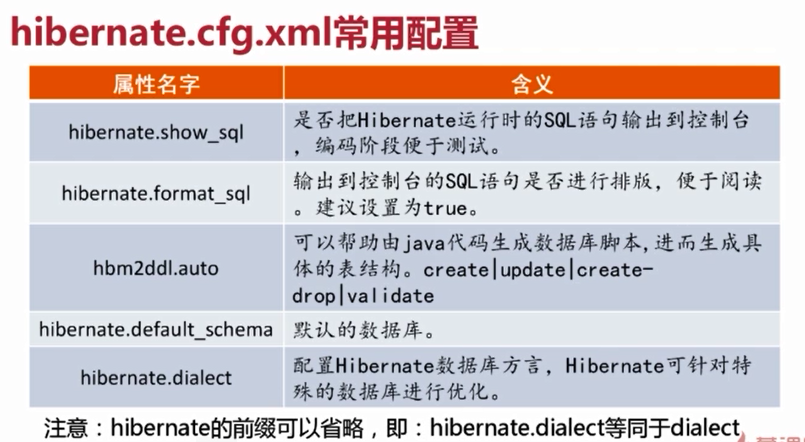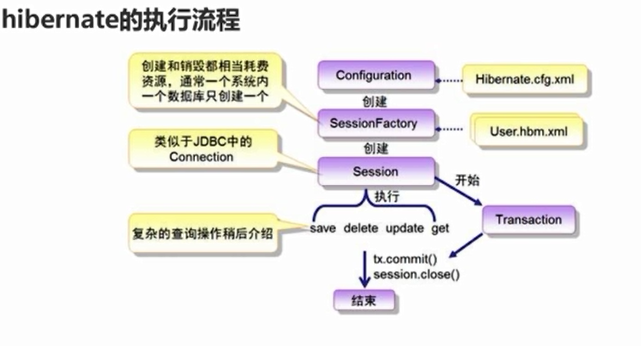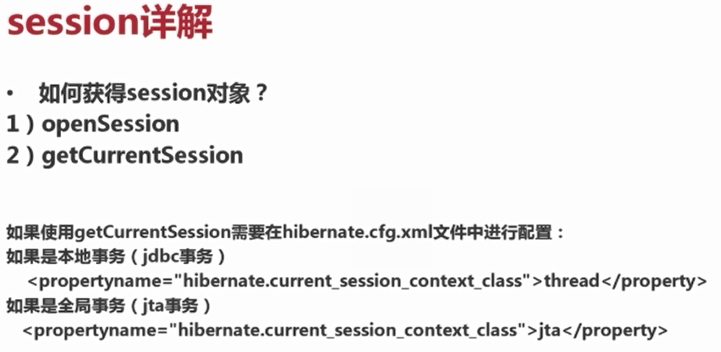1.Hibernate.cfg.xml常用配置
hibernate.show_sql 是否把Hibernate运行时的sql语句输出到控制台,值true、false
hibernate.format_sql 输出到控制台的sql语句是否格式化,值true、false
hbm2ddl.auto sql语句生成策略,值create、update、create-dorp、validate
hibernate.default_schema 默认的数据库
hibernate.dialect 配置数据库方言,可以优化sql语句。

2.Session对象简介
类似于jdbc的Connection,但Hibernate不建议使用Connection连接数据库。下图是Hibernate执行流程:

Session和Connection是多对一的关系,一个连接可以有多个会话。session常用方法有sava(),update(),delete(),createQuery(),
3.事务Transaction
Hibernate对数据库的操作都是封装在transaction中,并且默认都是费自动提交的。保存数据必须提交事务。可以通过session.doWork()设置自动提交,但并不推荐这么做!
@Test public void testSaveStudent(){ Students s=new Students(1,"张三丰","男",new Date(),"武当山"); session.doWork(new Work(){ @Override public void execute(Connection connection) throws SQLException { connection.setAutoCommit(true); } }); session.save(s); session.flush();//一定要有刷新会话的操作,sql才会立即执行 }
4.Session详解
获取session的两种方法:

这张图中需要强调的是使用getCurrentSession()必须在Hibernate.cfg.xml中进行配置参数!
getCurrentSession()和openSession()的区别
1)getCurrentSession()在事务提交或回滚后都会自动关闭,而openSession()需要手动关闭,如果多次不关闭会造成数据库连接池溢出。
试验方法:testOpenSession()、testGetCurrentSession()
2)getCurrentSession()是得到现有的Session,openSession()每次创建新的Session。
试验方法:testSavaStudentWithOpenSession()、testSavaStudentWithGetCurrentSession()。见如下代码:
import java.sql.Connection; import java.sql.SQLException; import java.util.Date; import org.hibernate.Session; import org.hibernate.SessionFactory; import org.hibernate.Transaction; import org.hibernate.cfg.Configuration; import org.hibernate.jdbc.Work; import org.hibernate.service.ServiceRegistry; import org.hibernate.service.ServiceRegistryBuilder; import org.junit.Test; public class SessionTest { @Test public void testOpenSession() { // 获取参数配置对象 Configuration config = new Configuration().configure(); // 获取服务注册对象 ServiceRegistry serviceRegistry = new ServiceRegistryBuilder() .applySettings(config.getProperties()).buildServiceRegistry(); // 得到SessionFactory对象 SessionFactory sessionFactory = config .buildSessionFactory(serviceRegistry); // session对象创建 Session session = sessionFactory.openSession(); Session session2 = sessionFactory.openSession(); if (session == session2) System.out.println("这是同一个session对象"); else System.out.println("这是不同的session对象"); if (session != null) { System.out.println("session创建成功!"); } else { System.out.println("session创建失败!"); } } @Test public void testGetCurrentSession() { Configuration config = new Configuration().configure(); ServiceRegistry serviceRegistry = new ServiceRegistryBuilder() .applySettings(config.getProperties()).buildServiceRegistry(); SessionFactory sessionFactory = config .buildSessionFactory(serviceRegistry); Session session = sessionFactory.getCurrentSession(); Session session2 = sessionFactory.getCurrentSession(); System.out.println(session == session2); if (session != null) { System.out.println("session创建成功!"); } else { System.out.println("session创建失败!"); } } @Test public void testSavaStudentWithOpenSession() { Configuration config = new Configuration().configure(); ServiceRegistry serviceRegistry = new ServiceRegistryBuilder() .applySettings(config.getProperties()).buildServiceRegistry(); SessionFactory sessionFactory=config.buildSessionFactory(serviceRegistry); Session session1=sessionFactory.openSession(); Transaction transaction=session1.beginTransaction(); Students s=new Students(1,"张三丰","男",new Date(),"武当山"); session1.doWork(new Work(){ @Override public void execute(Connection connection) throws SQLException { System.out.println("connection hashcode:"+connection.hashCode()); } }); session1.save(s); transaction.commit(); Session session2=sessionFactory.openSession(); transaction=session2.beginTransaction(); s=new Students(2,"孙中山","男",new Date(),"香港"); session2.doWork(new Work(){ @Override public void execute(Connection connection) throws SQLException { System.out.println("connection hashcode:"+connection.hashCode()); } }); session2.save(s); transaction.commit(); } @Test public void testSavaStudentWithGetCurrentSession() { Configuration config = new Configuration().configure(); ServiceRegistry serviceRegistry = new ServiceRegistryBuilder() .applySettings(config.getProperties()).buildServiceRegistry(); SessionFactory sessionFactory=config.buildSessionFactory(serviceRegistry); Session session1=sessionFactory.getCurrentSession(); Transaction transaction=session1.beginTransaction(); Students s=new Students(1,"张三丰","男",new Date(),"武当山"); session1.doWork(new Work(){ @Override public void execute(Connection connection) throws SQLException { System.out.println("connection hashcode:"+connection.hashCode()); } }); session1.save(s); transaction.commit(); Session session2=sessionFactory.getCurrentSession(); transaction=session2.beginTransaction(); s=new Students(2,"孙中山","男",new Date(),"香港"); session2.doWork(new Work(){ @Override public void execute(Connection connection) throws SQLException { System.out.println("connection hashcode:"+connection.hashCode()); } }); session2.save(s); transaction.commit(); } }
5.类配置文件hbm.xml常用配置:此地址
http://www.imooc.com/video/7718







 本文介绍了Hibernate框架的基本配置,包括核心配置文件hibernate.cfg.xml的常见参数设置,Session对象的作用及常用方法,事务Transaction的基本操作,以及类配置文件hbm.xml的常用配置。
本文介绍了Hibernate框架的基本配置,包括核心配置文件hibernate.cfg.xml的常见参数设置,Session对象的作用及常用方法,事务Transaction的基本操作,以及类配置文件hbm.xml的常用配置。
















 442
442

 被折叠的 条评论
为什么被折叠?
被折叠的 条评论
为什么被折叠?








